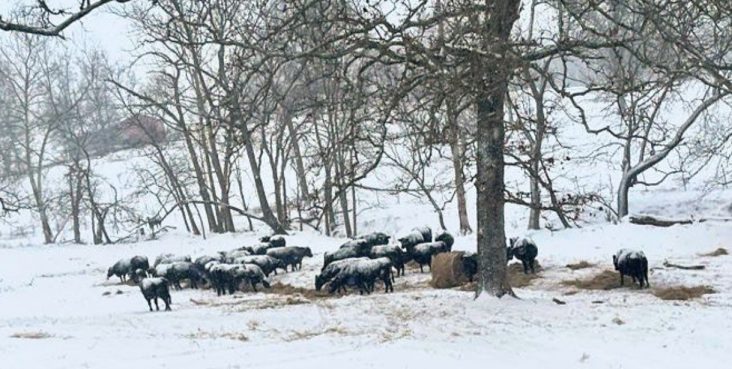Snow, bitter cold impact livestock in Arkansas
by February 15, 2021 5:35 pm 2,718 views

Cattle farm in Carroll Co. Photo courtesy of Arkansas Farm Bureau.
Single-digit wind chills, freezing water in pipes and troughs, and high snow loads on roofs are causing concerns for poultry and cattle operations, specialists from the University of Arkansas System Division of Agriculture said Monday (Feb. 15).
The record-setting storm front that stretches from Texas to Maine has caused millions to lose power as snowfall totals and bitter cold ravage almost half the country, according to the National Weather Service.
Low temperatures reported Monday morning to the National Weather Service included minus five at Compton, zero at Lead Hill and two degrees at Gilbert. At noon Monday, the North Little Rock airport had 10.9 inches of snow, while Greers Ferry, Perryville and Vilonia all reported 11 inches of snow, according to the National Weather Service.
In Northeast Arkansas, snow totals ranged from about four inches in places throughout the Ozark foothills, while some places recorded 10 inches of snow or more in areas around Jonesboro.
For poultry growers, “the biggest problems are having water pipes freezing and watering equipment not working,” said Dustan Clark, extension poultry specialist for the Division of Agriculture. Clark said many growers are putting space heaters and heat lamps in control rooms to keep pipes from freezing solid and to allow electronic control equipment to keep operating.
“Some are getting very little sleep – setting alarms and some are staying up all night – to check waterlines and birds,” he said. “Poultry growers that don’t have the best insulation – it’s going to be harder to keep those houses warm.”
“Roof collapse – that is a worry,” Clark said. “Depends on how much snow you’ve got. Most can handle it, but when we have eight inches of snow in this last round, and if we get much more – maybe 2-6 inches – that could be rough on some of those poultry houses.”
“Cows in good body condition and having a good winter coat are fairly tolerant of cold weather,” said Shane Gadberry, professor of ruminant nutrition and extension specialist. “Arkansas cattle are at a disadvantage because they haven’t had time to adapt to extremely cold temperatures.”
Gadberry said, “Thin cows, cows with short hair, lactating cows, and Brahman-influenced cattle breeds will have a little tougher time meeting the increased energy needs when it is cold and wet outside.”
There are certainly no snow days for ranchers, who have to be outside, no matter the weather. Cattle will need plenty of fresh water and quality hay while temperatures remain low, he added. However, when things start to thaw out, there will still be issues of concern for ranchers.
“When the temperature gets back to normal and the ground thaws, feeding areas may need to be relocated or ranchers may want to start unrolling hay to keep feeding sites distributed over larger areas to avoid creating deep mud tracks,” Gadberry said. “Deep mud makes it difficult for cattle to get to hay and eat as much as they could otherwise.”
Temperatures are predicted to stay bitterly cold during the entire week, the NWS predicted. A second winter storm is expected to envelop much of the state mid-week. Up to eight more inches of snow could fall in spots from Wednesday through Thursday. Temperatures are expected to rise above freezing during the weekend.
